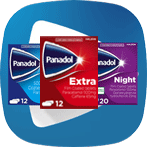The Flu – Symptoms, causes and treatment options
Aches, chills, coughs and fevers—the flu is a disturbing respiratory condition. To reduce the risk of spreading flu: wash your hands often with warm water and soap use tissues to trap germs when you cough or sneeze bin used tissues as quickly as possible. By detecting and treating symptoms early, you can help prevent the spread of the flu. But what are the symptoms? How does a flu differ from the common cold? And how can Panadol (Paracetamol) relieve symptoms of flu?
Flu – What are the signs, causes, and treatment options for flu?
The flu is a common seasonal viral infection of the respiratory tract.
The flu is caused by flu viruses that can spread quickly from one person to another. It is incredibly common, and most people will get the flu at some point in their lives. It can cause serious illness and, and in rare cases even death.
The World Health Organization estimates that around three to five million people suffer severe cases of flu each year. Most cases of flu can be treated at home with flu medicine and rest.

What are the most common flu symptoms?
It can be difficult to distinguish flu from the common cold. But the flu usually comes on more suddenly. A fever is often the first sign of the illness.
Flu usually begins abruptly. The exact symptoms will differ from person to person, but some of the first signs include fever, muscle pain, and a general feeling of discomfort and tiredness.
1. Fever: A fever happens when your body is trying to fight an infection. If your body temperature rises above 38 °C (100 F), you have a fever.
2. Myalgia: Muscle pain (or myalgia) is a common complaint of the flu. Your muscles might ache only in some places or it can feel like your entire body is hurting. There are many other reasons for myalgia, so if this is your only sign, it may not be flu.
3. Discomfort: Malaise describes a sensation of general weakness and discomfort. You will notice that something is not right and start to feel unwell. It’s often accompanied by fatigue when you have the flu.
Could it be coronavirus?
If you have a high temperature, a new, continous cough or a change in your sense of smell or taste, fatigue, you might be infected with the SARS COVID-19. Please seek medical advice (By clicking on the link you will be leaving the Panadol.com site and moving to an external website not managed by Haleon group of companies. Haleon assumes no responsibility for the site.): https://www2.hse.ie/conditions/covid19/symptoms/overview/
Flu symptoms – What to look out for?
Signs and symptoms of seasonal flu include a fever, cough, body aches and muscle pain, chills, fatigue and a general feeling of discomfort.
Because the flu spreads quickly, detecting symptoms early can encourage people to isolate and prevent further spreading of the virus. You’ll also be able to treat yourself quickly and avoid the illness getting worse.
Common signs of the flu are:
- Fever: A high temperature is a sign that your body is trying to fight a viral infection. For a reliable result, you should use a thermometer and measure your temperature inside your ear, mouth or buttocks (read the instruction on the label of the thermometer you are using). But not everyone with the flu gets a fever. According to estimates, around 70% of people get a flu without fever.
- Body aches: When you’re coming down with a flu or cold, body and muscle aches are incredibly common. You may feel achy in the back, legs, and head more than in other areas of the body.
- Chills: Shivers are a common reaction to your body preparing for a fever and often come on just before you notice a raised temperature.
- Fatigue: Feeling weaker and more tired than normal is one of the earliest symptoms of the flu. But be aware that fatigue alone is not always an indication of flu. Exhaustion is a common sign of many other illnesses.
- Cough: A dry cough, a tight chest, or wheezing may be indicators that you’re coming down with a flu. More often though, respiratory tract ailments come after the body aches and chills. Coughing can be very uncomfortable. It’s normal to cough up phlegm or mucus, but a persistent or lingering cough should be looked at by a healthcare professional.
- Sore throat: That itchy or sore throat you’re feeling is a common sign of flu. It may also be painful to swallow food or even drinks.
- Vomiting or diarrhoea: Not everyone who has the flu will suffer from gastrointestinal upset. But some people (and more commonly children) can feel nauseous and get diarrhoea.
What’s the difference between a cold and the flu?
Symptom |
Common cold |
Flu |
Onset |
Slow |
Sudden |
Fever |
Not common in adults or mild; more common in children |
Very common |
Headaches |
Sometimes |
Common |
Body aches |
Sometimes |
Common |
Fatigue |
Common |
Very common |
Stuffy and runny nose |
Very common |
Sometimes |
Sore throat |
Very common |
Sometimes |
Cough |
Common |
Common |

Flu medicine – How to treat flu
Treatment of seasonal flu usually includes bed rest, staying warm, and pain medication like Panadol 500 mg Film-Coated Tablets (paracetamol) for early symptoms of cold & flu and Panadol Cold & Flu Relief 500 mg / 65 mg Film-Coated Tablets for the relief of fever and/or pain such as sore throat or headache in the common cold or flu. Panadol Cold & Flu Film-Coated Tablets contain two active ingredients (paracetamol 500 mg and caffeine 65 mg). Paracetamol is a painkiller and reduces your temperature when you have a fever and caffeine acts to further help the effectiveness of paracetamol. If your symptoms persist or get worse, you should speak to a healthcare professional.
The flu can leave you feeling weak, tired, and unable to focus on your daily tasks. One of the most important things to do when you’re sick is to rest to help your body heal more quickly. From flu medicines to home remedies, which flu treatment you choose will often depend on the severity of your symptoms.
1. Rest and stay warm: If you notice flu symptoms, you should stay in bed. Sleep has been shown to be restorative and helps the body recover more quickly when you have the flu. It’s important that you stay at home to avoid spreading the virus to other people. Also wash your hands more often and use a tissue when sneezing.
2. Rehydrate: Drink plenty of fluids—water, electrolyte-enhanced drinks or decaf tea/coffee—to replenish lost fluids from diarrhea or vomiting. When your body sweats because of fever, you need to replace the lost water. Avoid caffeinated drinks as these can dehydrate you further.
3. Medicine: Paracetamol (the ingredient in Panadol) or ibuprofen can help lower a fever and make you feel better.
4. Antiviral drugs: Antiviral tablets are prescription medicines that help reduce the duration of the flu. They’re given to people who are at higher risk of developing complications from flu to avoid severe health consequences.
What are the complications from the flu?
With proper care and treatment, the flu isn’t serious in most cases and should go away within seven days. Symptoms such as a cough can linger longer.
Some people may also develop more severe symptoms and complications after they get the flu. These can be life-threatening so it’s important you recognize them early on.
1. Bronchitis: A viral infection can cause your airways to become irritated and inflamed. Signs of bronchitis include a cough with mucus, a tight chest, fever, and shivers. Bronchitis often precedes pneumonia. If your symptoms last for more than three weeks, make sure you see a healthcare professional.
2. Sinusitis: Symptoms of a sinus infection include pain and tenderness around the cheeks, forehead, nose, and eyes. Your nose will usually feel stuffy and blocked. There may also be a postnasal drip. Difficulty breathing should be treated by a healthcare professional right away.
3. Ear infection: If you notice a loss of hearing or discharge coming from one or both of your ears, it’s likely otitis media (more commonly known as a middle ear infection). The viruses that cause flu can occasionally/ rarely infect the ear. This should be looked at by a healthcare professional.
4. Lung infections: Lung infections can occasionally occur after a flu. It affects children under the age of five and the elderly or immunocompromised individuals more often. More than two million people worldwide die each year from pneumonia. Symptoms usually develop quickly and include a severe cough. You may also notice blood in your mucus. Lung infections could make it difficult to breathe and you may have severe chest pain. Elevated heartbeat, a high temperature, sweats, and shivers are common.
5. Encephalitis: Encephalitis is a very rare complication of the flu. It occurs when the flu virus enters the brain and causes inflammation of the nerve tissue. Signs of this infection include a severe headache, very high fever, nausea and vomiting, and mental confusion. You should call for emergency help if you have hallucinations, double vision, seizures or have difficulty speaking or hearing. Encephalitis is a medical emergency.

What is flu? The causes explained
The viruses that cause the flu are known as influenza type A, influenza type B, and influenza type C. Influenza type A is found in many species including humans, pigs, and birds; while types B and C mostly occur in humans (although dogs and pigs have been known to be infected with type C). The illness passes from person to person through droplets in the air when people sneeze or cough.
Worldwide, annual flu epidemics are estimated to result in about 3 to 5 million cases of severe illness. Children are more likely to get the flu than adults under the age of 65.
Although anyone can get the flu, some people are at a higher risk of developing complications. They include:
- Adults over the age of 65
- People with chronic health conditions like asthma, heart disease, diabetes, and kidney disease
- People with blood disorders or chronic lung disease
- People who are obese
- Children
- Adults who are immunocompromised
- Pregnant women
A Flu vaccine for Prevention
While flu is treatable and, in most people, does not cause severe complications, the best action is prevention. For more information please visit HSE website: Getting the flu vaccine - HSE.ie
Washing your hands regularly, avoiding touching your nose and mouth, and staying home if you’re not feeling well are other ways you can stop the spread of the flu.













